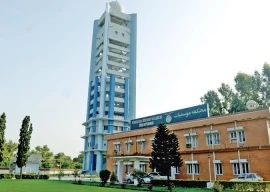
The infant mortality rate in Rawalpindi has seen a sharp spike over the past couple of years, revealed official statistics on Thursday.
A recent campaign aimed at providing preventive injections to children to safeguard them against 12 diseases shed light on the complexities and gaps in healthcare delivery.
The rising infant mortality rate has become a cause for concern, highlighting various challenges in ensuring child health and well-being.
The campaign aimed to immunise 171,300 newborns and children up to two years of age. However, 10,280 newborns couldn't be vaccinated as they already had succumbed to various health complications. This unfortunate reality has led to a decline in the growth rate of children in Rawalpindi district from 3.8 to 2.8, as per WHO standards.
The District Health Authority has responded to this crisis by launching a seven-day anti-polio campaign across five districts of Rawalpindi, commencing on April 29. This campaign aims to protect approximately 0.9 million children from polio in areas including Rawal Town, Cantonment Board, Potohar Town, Taxila, and Gujar Khan, with activities ranging from administering polio drops at fixed points to door-to-door vaccinations.
District Health Officer Dr Ehsan Ghani emphasised the critical importance of preventive vaccinations for children from birth to two years old, as these vaccinations are designed to shield them from a range of infectious diseases. The objective is to bolster immunity among children and reduce the incidence of preventable diseases.
Additionally, the campaign includes an awareness drive targeting pregnant women, urging them to undergo necessary vaccinations before childbirth to protect both themselves and their newborns.
The challenges contributing to infant mortality in Rawalpindi are multifaceted. Weakness in children, maternal health issues during pregnancy, inadequate medical check-ups and care, nutritional deficiencies, short intervals between childbirths, and various complications during pregnancy are among the factors contributing to this grim statistic. Despite efforts to include 174,756 pregnant women in the vaccination campaign, the struggle to ensure optimal maternal and child health persists.
The decline in the growth rate of children underscores the urgency of addressing these systemic issues. WHO's standards indicate a notable decrease in the growth rate, signalling a need for comprehensive strategies to improve healthcare access, maternal care, and childhood immunisation programmes.
Moreover, sustained efforts in healthcare provision, community education, and targeted interventions are imperative to reverse the trend of rising infant mortality rates. Collaborative initiatives involving healthcare professionals, government agencies, non-profit organisations, and communities are essential to ensure every child's right to a healthy start in life.
Published in The Express Tribune May 4th, 2024.

1725177144-0/Untitled-design-(8)1725177144-0-405x300.webp)
1725173339-0/Untitled-design-(6)1725173339-0-165x106.webp)





















COMMENTS
Comments are moderated and generally will be posted if they are on-topic and not abusive.
For more information, please see our Comments FAQ